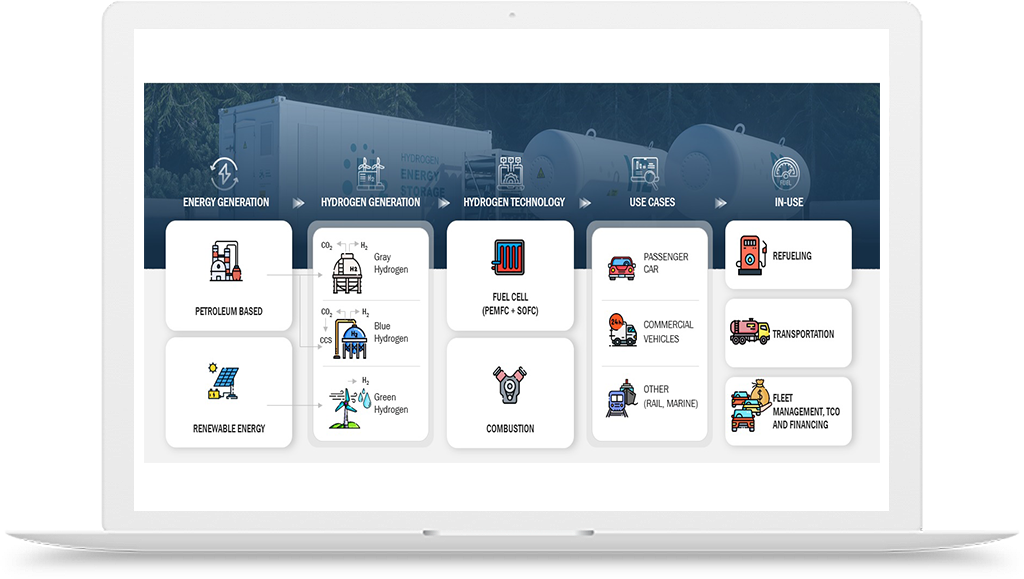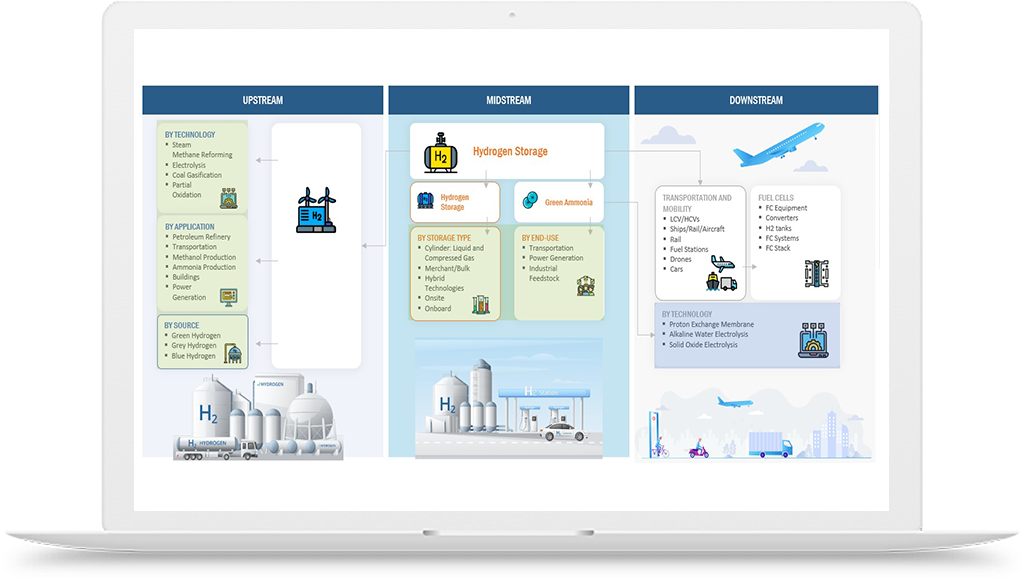What are the Opportunities for Green Hydrogen?
The global focus on sustainable energy solutions opens up enormous opportunities for green hydrogen, with potential applications ranging from a clean transportation fuel to efficient energy storage solutions.
In order to support the shift to a low-carbon and sustainable energy future, opportunities for green hydrogen must be explored. This includes making strategic investments in renewable energy projects, electrolysis technologies, and the creation of a green hydrogen infrastructure.
As countries and industries commit to decarbonization, opportunities for green hydrogen are becoming increasingly prominent, offering a versatile and eco-friendly solution to meet growing energy demands while mitigating the impact on the environment.
Green Hydrogen Opportunities
Green hydrogen presents significant opportunities for various sectors and applications. Here are some key opportunities associated with green hydrogen:
Decarbonizing Hard-to-Abate Sectors:
In industries like heavy industry, steel production, cement manufacturing, and chemical processes that are difficult to directly electrify, green hydrogen can be extremely helpful in reducing carbon emissions. These sectors frequently need for high-temperature heat or particular chemical reactions, which are challenging to accomplish with electricity alone. By employing green hydrogen as a clean energy source, these industries can cut their carbon emissions considerably and help meet the UN climate change targets.
Renewable Energy Storage:
Green hydrogen can serve as a large-scale energy storage solution for excess renewable energy. When renewable energy generation exceeds demand, the surplus electricity can be used to produce hydrogen through electrolysis. The stored hydrogen can be converted back into electricity during periods of high demand or when renewable energy generation is low, providing a reliable and dispatchable energy supply.
This energy storage capability enables better integration of intermittent renewable energy sources into the grid, helping to balance supply and demand and support the stability and resilience of the electricity system.
Fuel for Zero-Emission Transportation:
Hydrogen-powered trains and fuel cell cars are just two examples of the transportation vehicles that can run on green hydrogen. The drawbacks of battery electric vehicles can be addressed by green hydrogen, which can replace fossil fuel-powered vehicles and provide zero-emission mobility with long driving ranges and quick refueling times.
Since the transportation industry contributes significantly to global carbon emissions, using green hydrogen as fuel can help improve air quality, lower air pollution, and create a more sustainable and environmentally friendly transportation system.
Energy Export and Global Trade:
Green hydrogen can be produced in nations with an abundance of renewable energy resources and exported to areas with less potential for renewable energy. Energy security and economic expansion are facilitated by the opportunities this generates for energy export and international trade. Green hydrogen possesses the capacity to transform into a worldwide good, allowing nations to capitalize on their renewable energy resources and position themselves as major participants in the hydrogen economy.
Job Creation and Economic Growth:
Green hydrogen's widespread use offers prospects for economic expansion and job creation. Both capital and skilled labor will be needed for the construction of green hydrogen infrastructure, such as electrolyzers, storage facilities, and distribution networks. This could spur economic growth in areas that invest in the hydrogen industry and result in the creation of new jobs along the whole hydrogen value chain, from production to distribution.
Technological Innovation and Research:
Research and development must continue if green hydrogen technologies are to advance. This makes room for technological innovation and raises the efficiency, cost-effectiveness, and scalability of hydrogen storage, production, and use. Research and innovation expenditures have the potential to produce breakthroughs in materials, catalysts, and electrolyzer technologies, which would accelerate the development of the green hydrogen sector.
Green hydrogen offers opportunities for decarbonizing hard-to-abate sectors, enabling renewable energy storage, fueling zero-emission transportation, promoting energy export and trade, creating jobs, driving economic growth, and fostering technological innovation. These opportunities highlight the transformative potential of green hydrogen in achieving sustainable and low-carbon energy systems.
According to a report by the Hydrogen Council, "Path to Hydrogen Competitiveness: A Cost Perspective," published in 2020:
Job Creation and Economic Growth:
- The report estimates that the global hydrogen economy could generate $2.5 trillion in annual revenue and create more than 30 million jobs by 2050.
- It further states that the hydrogen industry could contribute to 18% of the world's energy-related greenhouse gas emissions reduction by 2050.
These statistics highlight the significant economic potential and job creation opportunities associated with the development and expansion of the hydrogen sector, including green hydrogen.
Additionally, some countries and regions have set ambitious targets and made substantial investments in green hydrogen:
Germany:
- Germany has set a target to have 5 gigawatts (GW) of electrolyzer capacity by 2030 and aims to become a global leader in green hydrogen technologies.
- The German government has allocated €9 billion ($10.7 billion) in funding for hydrogen-related projects.
European Union:
- The European Union (EU) has included hydrogen as a key part of its strategy to achieve carbon neutrality by 2050.
- The EU's Hydrogen Strategy aims to install at least 40 GW of electrolyzer capacity by 2030 and aims to produce up to 10 million metric tons of renewable hydrogen within the EU.
These examples demonstrate the strong commitment and investments made by governments and regional blocs to promote the development and utilization of green hydrogen, supporting its potential for economic growth and decarbonization.
Several industries are already utilizing or exploring the use of green hydrogen as a clean and sustainable energy source. Here are some industries actively adopting or considering green hydrogen:
Use of Green Hydrogen in Transportation Industry:
- Automotive Industry: Companies such as Toyota, Hyundai, and BMW are manufacturing and selling hydrogen fuel cell vehicles (FCVs) that use green hydrogen as fuel. These FCVs offer zero-emission transportation with long driving ranges and quick refueling times.
- Aviation: The aviation industry is exploring the use of green hydrogen as a sustainable fuel for aircraft. For example, ZeroAvia, a startup, is developing hydrogen-electric powertrains for commercial aircraft.
- Maritime: The maritime sector is actively exploring the adoption of green hydrogen as a clean fuel for ships, including fuel cells for propulsion and auxiliary power systems. The European Marine Energy Centre (EMEC) is conducting trials of a hydrogen-powered ferry.
Green Hydrogen Opportunities in Energy and Power Generation Industry:
- Power-to-Gas: The process of converting excess renewable energy into hydrogen through electrolysis can make use of green hydrogen. Hydrogen has multiple applications, such as power generation, and can be stored or injected into the natural gas grid.
- Combined Heat and Power (CHP) Plants: : Green hydrogen is a fuel that can be used in CHP plants to produce heat and electricity efficiently. These plants have the potential to aid in the decarbonization of the electricity and heat industries.
Green Hydrogen usage in Industry and Manufacturing:
- Steel Production: The steel industry is exploring the use of green hydrogen as a reducing agent to replace the use of coking coal in the steelmaking process, reducing carbon emissions.
- Chemical Industry: Green hydrogen can be utilized as a feedstock or energy source in various chemical processes, reducing reliance on fossil fuels and contributing to the decarbonization of the chemical industry.
- Refining: Green hydrogen can be used in the refining process, replacing fossil fuels and reducing the carbon intensity of petroleum refining.
Green Hydrogen Potential in Energy Storage and Grid Balancing Industry:
- Renewable Energy Storage: Green hydrogen can serve as a large-scale energy storage solution for excess renewable energy, helping to balance supply and demand. Hydrogen produced during periods of low demand can be converted back into electricity when renewable energy generation is low, ensuring a stable and reliable energy supply.
- Grid Balancing: Green hydrogen can be used to support grid balancing and stability by providing a dispatchable source of energy that can be readily converted back into electricity during peak demand periods or when renewable energy production is limited.
















